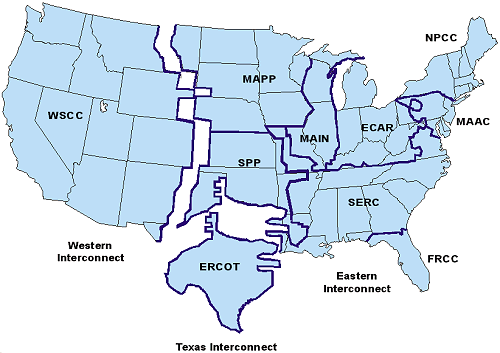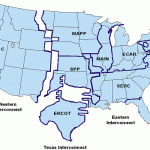The U.S. electric power industry, the last major regulated energy industry in the United States, is changing to be more competitive. In some States, retail electricity customers can now choose their electricity company. New wholesale electricity trading markets, which were previously nonexistent, are now operating in many regions of the country. The number of independent power producers and power marketers competing in these new retail and wholesale power markets has increased substantially over the past few years. To better support a competitive industry, the power transmission system is being reorganized from a balkanized system with many transmission system operators, to one where only a few organizations operate the system. However, the introduction of these new markets has been far from seamless. California, where retail competition was introduced in 1998, has had problems recently. Electricity prices in some parts of the State have tripled and there have been supply problems as well. Although not as severe as California, New York’s electricity market has had price spikes which may be attributable to problems in the market design. While some observers argue that deregulation should be scrapped, others argue that deregulation is a noble endeavor and that these problems can be solved with structural adjustments to the markets.
This reorganization is actually the second major structural realignment in the history of the industry. The first occurred during the late 1920s and early 1930s. However, the changes then were mandated by a Federal law that was designed to stop holding company misconduct. Today, the changes that are occurring are not driven by misconduct, but rather by economic and technological factors. In fact, three primary catalysts are driving the current movement toward a restructured electric power industry. First is a general reevaluation of regulated industries and a rethinking of how the introduction of competition might improve efficiencies. The telecommunications and banking industries have been made more competitive, and the electric power industry is being evaluated for similar efficiency gain potential. The second factor driving the restructuring debate is the wide disparity of electricity rates across the United States (Figure ES1). In 1998, consumers in New York paid more than two and one-half times the rates that consumers in Kentucky paid for their electricity. In the western United States, the rates paid by consumers in California were well over twice the rates paid by consumers in Washington. Technological improvements in gas turbines have changed the economics of power production. No longer is it necessary to build a 1,000- megawatt generating plant to exploit economies of scale. Combined-cycle gas turbines reach maximum efficiency at 400 megawatts, while aero-derivative gas turbines can be efficient at scales as small as 10 megawatts. These improvements, involving less capital investment and less time to build capacity, are the third set of catalysts driving restructuring.
Because it provides the capability to move power over long distances, the transmission system is an integral component of the Nation’s electric power industry. Through regulatory reform, the Federal Energy Regula-tory Commission (FERC) has promoted the development of competitive wholesale power markets and opening the transmission system to all qualified users. Since the late 1980s, FERC has approved more than 850 applications to sell power competitively in wholesale markets. In arguably its most ambitious effort to date, in December 1999, FERC issued Order 2000 calling for electric utilities to form regional transmission organizations (RTOs) that will operate, control, and possibly own the Nation’s power transmission system. The potential benefits of RTOs are the elimination of discriminatory behavior in using the transmission system, improved operating efficiency, and increased reliability of the power system.
A number of States have played an active role in promoting retail competition in the electric power industry. Relatively high-cost States have been in the forefront of enacting legislation or making rules to allow retail competition. California and the northeastern States were the first to allow retail competition and encourage consumers to shop for their power suppliers. Other States such as Kentucky and Idaho, whose rates are among the lowest in the country, are not moving as quickly. A recent report issued by Kentucky’s Special Task Force on Electricity Restructuring found no compelling reason for Kentucky to move quickly to restructure its electric power industry. As of July 1, 2000, 24 States and the District of Columbia had enacted legislation or passed regulatory orders to restructure the electric power industry (Figure ES2).
While most of the States have been active in restructuring their own jurisdictions, several bills designed to provide a single Federal framework for wholesale and retail competition have been introduced into the U.S. Congress. These bills address myriad restructuring issues such as reliability, reform of Federal power marketing administrations, a public benefits fund, tax issues, and renewable energy portfolio standards. Extensive hearings and debates have been held to understand the interests and concerns of all parties involved in the industry, and reaching consensus has been an imposing pursuit. The recent price spikes in California will certainly be a topic of discussion as the restructuring debate moves forward. Retail prices in San Diego have tripled in some cases over the summer of 2000 and there have been blackouts in the San Francisco Bay area. Any discussion surrounding new bills will most certainly address mitigation of these price spikes and supply curtailments. In all likelihood, Congress will be involved in these activities for a number of months before any comprehensive restructuring legislation will be passed.
Mergers, acquisitions, and divestitures of power plants have become widespread as investor-owned utilities (IOUs) seek to improve their positions in the increasingly competitive electric power industry. Since 1992, IOUs have been involved in 35 mergers, and an additional 12 mergers are pending approval. One effect of these mergers is that the size of IOUs is increasing. In 1992, the 10 largest IOUs owned 36 percent of total IOU-held generation capacity, and the 20 largest IOUs owned 58 percent of IOU-held generation capacity. By the end of 2000, the 10 largest IOUs will own an estimated 51 percent of IOU-held generation capacity, and the 20 largest will own approximately 72 percent. While the size of the largest IOUs is increasing, because of generation divestitures, they generally own a smaller proportion of total generating capacity than in the past. In addition to mergers within the electricity industry, IOUs–seeing growth opportunities in the natural gas industry–are merging with or acquiring natural gas companies, contributing to what is referred to as convergence of the two industries. In the last 3 years, 23 convergence mergers have been completed or are pending.
Influenced predominantly by State-level electricity industry restructuring programs that emphasize the unbundling of generation from transmission and distribution, and in some cases by a desire to exit the competitive power generation business, IOUs are divesting power generation assets in unprecedented numbers. Since late 1997, IOUs collectively have divested or are in the process of divesting 156.5 gigawatts of power generation capacity, representing about 22 percent of total U.S. electric utility generation capacity. Divestiture means that the IOU will either sell its generation capacity to another company or transfer the generation capacity to an unregulated subsidiary within its own holding company structure. As a result of mergers and divestitures during the past few years, the organizational structure of the electric power industry (i.e., the numbers and roles of the industry participants) is changing. The traditional role of the electric utility as a provider of electric power is giving way to the expanding role of nonutilities as providers of electric power. An analysis of electric power data collected by the Energy Information Administration for the period 1992 through 1998 offers the following insights:
The number of IOUs has decreased by 8 percent (261 in 1992 vs. 239 in 1998), while the number of nonutilities generating electricity has increased by 9 percent (1,792 in 1992 vs. 1,954 in 1998).
Nonutilities are expanding and buying utility-divested generation assets, causing their net generation to increase by 42 percent (286 million megawatthours in 1992 vs. 406 million megawatthours in 1998) and their nameplate capacity to increase by 73 percent (57 thousand megawatts in 1992 vs. 98 thousand megawatts in 1998). Nonutility capacity and generation will increase even more as they acquire additional utility-divested generation assets over the next few years.
The nonutility share of net generation rose from 9 percent (286 million megawatthours) in 1992 to 11 percent (406 million megawatthours) in 1998.
Utilities have historically dominated the addition of new capacity. However, utilities are adding less capacity, while nonutility additions to capacity have been increasing at an average annual rate of nearly 7 percent since 1992. In 1998 alone, the nonutility share of additions to capacity was 82 percent (5,396 megawatts) with utilities adding 1,185 megawatts or 18 percent.
Since 1998, it is expected that these trends have continued.
More From SolarStorms.org:
Submit your review | |









